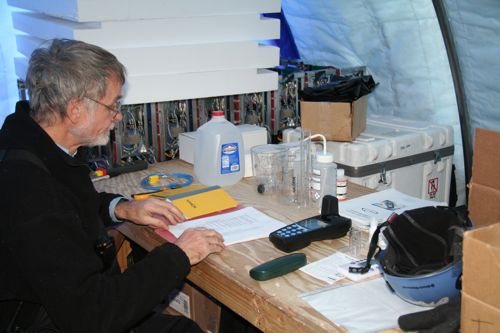The season is ramping up for installation of the IceCube detector strings, and also for the deployment of the IceTop surface sensor tanks. Today was a big day in that we were able to fill our first two tanks, getting them started on the long road to becoming crystal clear ice. Unfortunately, the IceCube detector strings may be a little delayed due to a faulty generator. But these guys are pros, they are working out different options that will allow them to remain on schedule with minimal risk.
 Sun dogs, like halos, are an atmospheric phenomenon caused by ice crystals in the air. Look for the bright spots directly on each side of the sun. I am blocking the sun out using my finger, otherwise it would be too bright and you wouldn't see the sun dogs.
Sun dogs, like halos, are an atmospheric phenomenon caused by ice crystals in the air. Look for the bright spots directly on each side of the sun. I am blocking the sun out using my finger, otherwise it would be too bright and you wouldn't see the sun dogs.
One thing about the IceCube project - it is HUGE! It is the largest research project ever attempted in Antarctica, with approximately $300 million in funds from the US and additional from other nations and organizations. And unlike most enormous projects along these lines, it is apparently on schedule and within budget! That is amazing and nearly unheard of on a project like this.
 Dr. Hermann Kolanoski samples and tests the water we will use to fill the IceTop tanks. Often it gets contaminated with glycol (antifreeze) or other chemicals, which can interfere with the freezing process.
Dr. Hermann Kolanoski samples and tests the water we will use to fill the IceTop tanks. Often it gets contaminated with glycol (antifreeze) or other chemicals, which can interfere with the freezing process.
OK, back to the IceTop tanks. When completed next year, the IceTop surface array will cover a square kilometer of South Pole surface ice, including 86 pairs of tanks, each with a pair of DOMs (Digital Optical Modules, the same light sensors being used in the IceCube strings deep under the ice), for a grand total of 344 sensors to detect the shower of subatomic particles that flies through the air whenever a cosmic ray hits the atmosphere. For a brief discussion of how the sensors work, see this animated introduction to IceCube.
Each tank holds several hundred gallons of water, which freezes around the DOMs, into perfectly clear ice. In this journal I posed the question, how can you get ice to freeze perfectly clear? Did you figure it out? So let's try to answer that. The main culprit in forming bubbles in ice is the tiny molecules of gas (oxygen, nitrogen, carbon dioxide, etc) that are dissolved in the water. Normally you don't even notice this dissolved gas, but it is important for things like fish, whose gills allow them to breathe the dissolved oxygen, and water plants, who can use the dissolved carbon dioxide in photosynthesis.
 James Roth places the contactor assembly into the tank - this is a pump connected to a device that removes the dissolved gases from the water. It is in contact with the water, thus the name.
James Roth places the contactor assembly into the tank - this is a pump connected to a device that removes the dissolved gases from the water. It is in contact with the water, thus the name.
So, how do you get rid of the dissolved gas? The IceTop tanks do it by running the water through a "contactor assembly" that pumps the water through tiny tubes, with very low pressure on the outside. The water stays in the tubes, but the dissolved gases can go through the tube material to the low pressure, where they get released out into the air. Voila! no more dissolved gases!
 The Freeze Control Unit (FCU) keeps track of temperatures and water levels, and runs the pumps that make sure the ice freezes perfectly clear.
The Freeze Control Unit (FCU) keeps track of temperatures and water levels, and runs the pumps that make sure the ice freezes perfectly clear.
They also do other tricks, such as circulating the water constantly so it freezes evenly, and pumping out a little extra water to keep the ice from expanding and cracking or damaging the DOMs. Very high tech ice cube makers! We will come back in 3 days to check on these tanks; apparently the water will still be liquid, but we will then open up the tanks to the freezing cold air to start the freezing process which will take weeks to freeze entirely solid!
 Each IceTop tank gets two DOMs, which will become embedded in ice after we fill the tanks.
Each IceTop tank gets two DOMs, which will become embedded in ice after we fill the tanks.
As a side note: the IceCube 2.5 km deep holes do not need these tricks - the intense pressure of the water at the bottom naturally keeps the dissolved gases from forming bubbles, at least any bubbles that would cause them problems.

